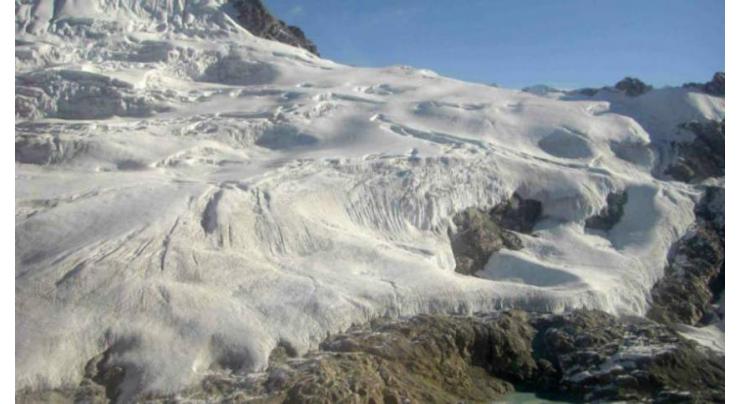
Mountain Glaciers Melting Rate In Himalayan Region Doubled Since 2005: Report
Rukhshan Mir (@rukhshanmir) Published December 10, 2018 | 08:42 PM

The melting rate of lofty glaciers of Himalayan region, housing the third largest mass of frozen freshwater on Earth, has doubled since 2005.
More than 500 small glaciers have vanished as the ice in both the North and the South poles are rapidly melting and warming climate is also putting the world's Third Pole in jeopardy, where the glaciers are retreating at an accelerating rate.
According to a report of China Global Television Network (CGTN), apart from global warming, pollution and dust have further contributed to the deteriorating situation.
The Himalayan region is home to almost 50,000 mountain glaciers on the planet -- one quarter of the world's total -- and cradle of 10 major rivers in Asia.
It powers life for some 1.3 billion people in China, India, Pakistan, Nepal, Bhutan, Bangladesh and Afghanistan.
But the glacier retreat is threatening everyday life, from irrigation to power generation to drinking water. Moreover, avalanches, earthquakes and floods have taken place more frequently than ever.
The Himalayas poses a special challenge in global climate governance. "Climate change will not only affect the eco-environment but also health, food security and cause natural disasters and even a water crisis," said Nicholas Rosellini, the UN resident coordinator in China at a recent symposium in Beijing, co-hosted by the UN Development Program, the Himalayan Consensus Institute, and the Center for China and Globalization.
Climate change in the Himalayas has evolved to be a humanitarian issue that required the coordinated effort of all stakeholders. The conflicts in the region and climate change impoverish people in the region.
An early warning system against natural disasters would also help shield local residents from displacement and poverty.
China has lifted over 700 million people out of poverty over the past forty years since its reform and opening up, which is an unparalleled achievement. This also means that the country has dealt with poverty in many forms, and can share the breadth of its experiences with other countries in the region to improve the livelihood of Himalayan communities.
In the meantime, China and other regional countries can jointly protect water resources for these communities, said Wang Liyan, a senior official for climate change projects in the Embassy of Switzerland in China who has been working in groundwater management in this region for the past four years.
The year of 2013 saw a peak in the amount of water melting from the glaciers in the Himalayas because of climate change, and the next peak may come in 20 years. This interval provides an opportunity to work together in exploring efficient water conservation models.
Separately, green bonds, which were created to fund projects with positive environmental benefits, are helping communities transition away from fossil fuels � a key contributor to climate change � for some of the remotest regions in the Himalayas.
Wang Hongbin, president of the Greater China region of Euromoney, noted that China holds the largest amount of green bonds, so it can cooperate in this regard.
Hopefully, with concerted efforts, the estimation that glaciers in the famed Himalayas could have their volume drop by 70-99 percent by 2100 will not come true.
Related Topics
Recent Stories

HEC reviews curricula for environmental sciences degree programme

ICC Asia looking forward to an action-packed Asia Cricket Week

Yuvraj Singh named ICC Men’s T20 World Cup 2024 Ambassador

Greece hands Olympic flame to 2024 Paris Games hosts

Two Kyiv hospitals evacuating over feared Russian strikes

World must act on neurotech revolution, say experts

Charles & Catherine's cancer diagnoses

Champions Alcaraz and Sabalenka through in Madrid Open

King Charles to resume some public duties during cancer treatment: palace

US defense chief announces $6 bn in security aid for Ukraine

Heavy rains cause damage to Spezand-Taftan railway track

Woman stabbed in Israel, attacker killed: police
More Stories From World
-
NFL will allow players to wear Guardian Cap helmets in games
4 hours ago -
Football: German Bundesliga table
4 hours ago -
Football: Italian Serie A result
4 hours ago -
Football: German Bundesliga results
4 hours ago -
US troops to leave Chad in second African state withdrawal
4 hours ago -
Plastics pollution may be solved without production cap: Canada minister
5 hours ago
-
Biden stalls on menthol cigarette ban fearing Black vote backlash
5 hours ago -
Champions Alcaraz and Sabalenka through in Madrid Open
5 hours ago -
6,000 French police to welcome Olympic torch amid bonus boost
5 hours ago -
Taiwan hit by several quakes, strongest reaching 6.1-magnitude
5 hours ago -
'Ballistic' Bairstow stars as Punjab pull off record T20 chase
5 hours ago -
Tennis: ATP/WTA Madrid Open results - 2nd update
5 hours ago